What’s Up?
Eric Bowles and I explored Harris Neck NWR on Tuesday morning. It turned out to be one of those making-soup-from-a-stone days, a little of this and a little of that. We found a nice sunrise spot out of the park proper and had a sweet sunrise without many birds. 🙁 We visited several ponds on the refuge. The best by far was Woody Pond, in part because it actually had water in it. I got to see the famed Wood Stork rookery from a distance; the only photographs to be made of the breeding storks were scenic images of the nesting islands. We had several gators, a Tricolored Heron, and a very cooperative Great Blue Heron; we worked that bird hard and did well thanks to the clouds. It had gotten very windy on the way home. I had noticed roadsides full of Indian Blanket Flower in bloom on the way into Jekyll, so I suggested that we stop to do some blurs, and we did just that.
After lunch and a nap, it got really stormy, so we headed back to the causeway to do some more blurs. I again went with the 200-600 with a 5-stop ND filter screwed onto the front with the lens on a tripod so that I could try some circle blurs. I had put chicken and butternut squash in the oven at 360° so we headed back to Villas By the Sea after an hour of shooting while dodging a few raindrops. Dinner was done perfectly and was delicious.
Today is Wednesday 6 April. The forecast for the morning is for mostly cloudy with a SW wind. That is pretty bad for bird photography unless you have lots of cloud cover… We have just today shooting on our own till the boys and girls arrive. Starting very early on Thursday, GNPA will keep me very busy until midday on Sunday. That will be followed with a 2 1/2-day IPT. Wherever you are and whatever you are doing, I hope that you too have a great day. This blog post took about 45 minutes to prepare and makes twenty-seven days in a row with a new one.
Please remember to use the B&H and Amazon links that are found on most blog pages and to use the BIRDSASART discount code at checkout when purchasing your new gear from Bedfords. Please, also, consider joining a BAA IPT. You will be amazed at how much you will learn …
And Please Remember
You can find some great photo accessories (and necessities, like surf booties!) on Amazon by clicking on the Stuff tab on the orange/yellow menu bar above. On a related note, it would be extremely helpful if blog-folks who, like me, spend too much money on Amazon, would get in the habit of clicking on the Amazon logo link on the right side of each blog post when they shop online. As you might expect, doing so will not cost you a single penny, but would be appreciated tremendously by yours truly. And doing so works seamlessly with your Amazon Prime account.
Please remember that if an item — a Delkin flash card, or a tripod head — for example, that is available from B&H and/or Bedfords, is also available in the BAA Online Store, it would be great, and greatly appreciated, if you would opt to purchase from us. We will match any price. Please remember also to use my B&H affiliate links or to earn 3% cash back at Bedfords by using the BIRDSASART discount code at checkout for your major gear purchases. Doing either often earns you free guides and/or discounts. And always earns my great appreciation.
Brand-New and As-Good-As-Ever Bedfords BAA Discount Policy
Folks who have fallen in love with Bedfords can now use the BIRDSASART coupon code at checkout to enjoy a post-purchase, 3% off-statement credit (excluding taxes and shipping charges) on orders paid with a credit card. The 3% credit will be refunded to the card you used for your purchase. Be sure, also, to check the box for free shipping to enjoy free Second Day Air Fed-Ex. This offer does not apply to purchases of Classes, Gift Cards, or to any prior purchases.
Money Saving Reminder
Many have learned that if you need a hot photo item that is out of stock at B&H and would like to enjoy getting 3% back on your credit card along with free 2nd Day Air Fed-Ex Air shipping, your best bet is to click here, place an order with Bedfords, and enter the coupon code BIRDSASART at checkout. If an item is out of stock, contact Steve Elkins via e-mail or on his cell phone at (479) 381-2592 (Central time). Be sure to mention the BIRDSASART coupon code and check the box for Free Shipping. That will automatically upgrade to free 2nd Day Air Fed-Ex. Steve has been great at getting folks the hot items that are out of stock at B&H and everywhere else. The waitlists at the big stores can be a year or longer for the hard-to-get items. Steve will surely get you your gear long before that. For the past year, he has been helping BAA Blog folks get their hands on items like the SONY a 1, the SONY 200-600 G OSS lens, the Canon EOS R5, the Canon RF 100-500mm lens, and the Nikon 500mm PF. Steve is personable, helpful, and eager to please.
Important Note
As an Amazon Associate, I earn a small percentage when you purchase from Amazon after using any of the Amazon links on the blog (including the logo-link immediately above). My link works with Amazon Prime and using it will not cost you a single cent. Huge thanks, BTW 🙂
Please Remember Also
Please, if you enjoy and learn from the blog, remember to use one of my two affiliate programs when purchasing new gear. Doing so just might make it possible for me to avoid having to try to get a job as a Walmart greeter and will not cost you a single penny more. And if you use Bedfords and remember to enter the BIRDSASART code at checkout, you will (still!) save 3% on every order and enjoy free second-day air shipping. In these crazy times — I lost about fifty thousand dollars in income due to COVID 19 — remembering to use my B&H link or to shop at Bedfords will help me out a ton and be greatly appreciated. Overseas folks who cannot order from the US because of import fees, duties, and taxes, are invited to help out by clicking here to leave a blog thank you gift if they see fit.


Gear Questions and Advice
Too many folks attending BAA IPTs and dozens of photographers whom I see in the field and on BPN, are–out of ignorance–using the wrong gear, especially when it comes to tripods and more especially, tripod heads… Please know that I am always glad to answer your gear questions via e-mail. If you are desperate, you can try me on my cell at 863-221-2372. Please leave a message and shoot me a text if I do not pick up.
|
|
|
This image was created on 4 April 2022 on the Jekyll Island Causeway. I used the hand held Sony FE 200-600mm f/5.6-6.3 G OSS lens (at 496mm), and The One, the Sony Alpha 1 Mirrorless digital camera. ) The exposure was determined using Zebra technology with ISO on the Thumb Dial. ISO 50. 1/8 second at f/16 (wide open). AWB at 11:39:13am on a cloudy very bright morning. Spot S! AF-C did just what I wanted it to. Be sure to click on the image to enjoy a high-res version. Image #1: Roadside wildflower wind blur
|
Gorgeous or Garbage?
Your honest thoughts would be appreciated.
More On 200-600 Versatility
The Sony 2-6 continues to amaze me with its versatility. I used it on Tuesday with high ISOs to create sunrise scenics, sharp images of the perched and fishing Great Blue Heron, bird-scapes of the Wood Stork Rookery, and all sorts of gator shots. Lastly, it was great on the causeway for shooting the flower blurs both handheld and on a tripod. One negative? Turning the lens in the tripod collar was a bit sticky. It does not rotate smoothly as the 600 f/4 does.
|
|
A Guide to Pleasing Blurs
Learn everything there is to know about creating pleasingly blurred images in A Guide to Pleasing Blurs by Denise Ippolito and yours truly. This 20,585-word, 271-page PDF is illustrated with 144 different, exciting, and artistic images. The guide covers the basics of creating pleasingly blurred images, the factors that influence the degree of blurring, the use of filters in creating pleasing blurs, and a great variety of both in-the-field and Photoshop techniques that can be used to create pleasingly blurred images.
Artie and Denise teach you many different ways to move your lens during the exposure to create a variety of pleasingly blurred images of flowers and trees and water and landscapes. They will teach you to recognize situations where subject movement can be used to your advantage to create pan blurs, wind blurs, and moving water blurs. They will teach you to create zoom-blurs both in the field and during post-processing. Artie shares the techniques that he has used and developed for making blurred images of flocks of geese in flight at his (formerly) beloved Bosque del Apache and Denise shares her flower blur magic as well as a variety of creative Photoshop techniques that she has developed.
With the advent of digital capture creating blurred images has become a great and inexpensive way to go out with your camera and have fun, especially when there is not much light. And while many folks think that making successful blurred images is the result of being a sloppy photographer, nothing could be further from the truth. In “A Guide to Pleasing Blurs” Artie and Denise will help you to unleash your creative self.
|
|
|
Fort DeSoto in spring is rife with tame birds, many in full breeding plumage. Click on the composite to enjoy a larger version. Clockwise from upper left around to center: Laughing Gull landing on head of Brown Pelican, Laughing Gull in flight, Reddish Egret sunrise silhouette, Great Blue Heron with needlefish, Yellow-crowned Night Heron with ghost crab, Roseate Spoonbill, Sanderling in breeding plumage, and white morph Reddish Egret in glorious breeding plumage. |
The 2022 DeSoto Spring IPT/April 26 through the morning session on April 29, 2020. 3 1/2 DAYS: $2099.00. Limit: 6 photographers/Openings 3
Fort DeSoto, located just south of St. Petersburg, FL, is a mecca for breeding terns and gulls and wading birds in spring. Migrant shorebirds are in abundance, and many are exceedingly tame. We should have great chances on Royal and Sandwich Terns and both white- and dark-morph Reddish Egrets. Great Egret, Snowy Egret, Great Blue Heron, Tricolored Heron, and White Ibis are easy as well and we will almost surely come up with a tame Yellow-crowned Night-Heron or two along with some American Oystercatchers. We will enjoy lots of great flight photography.
|
|
|
Again, Fort DeSoto in spring is rife with tame birds, most in breeding plumage. Click on the composite to enjoy a larger version. Clockwise from upper left around to center: Laughing Gull in flight, Yellow-crowned Night-Heron, Sandwich Terns copulating, Roseate Spoonbill, Great Egret with reflection, breeding plumage Short-billed Dowitcher, American Oystercatcher, Royal Tern, white morph Reddish Egret, and Snowy Egret in marsh. |
We will also get to photograph a variety of other shorebirds including Black-bellied, Semipalmated, Wilson’s, and Piping Plovers, Willet, Dunlin, Short-billed Dowitcher, most especially, Red Knot with many individuals in their handsome breeding plumages. In spring the T-shaped peninsula and the newly formed sandbar, Outback Key, are literally packed with avian treasures.
With luck, we might get to photograph one of Florida’s most desirable species: Roseate Spoonbill. And we will almost surely get to do some Brown Pelican flight photography. With luck, they will have Laughing Gulls landing on their heads. And though not guaranteed, Wood Stork might well be expected. And we will be on the lookout for a migrant passerine fallout in the event of a thunderstorm or two.
|
|
|
Yes, Fort DeSoto in spring is rife with tame birds, most in breeding plumage. Click on the composite to enjoy a larger version. Clockwise from upper left around to center: breeding plumage Dunlin, dark morph Reddish Egret displaying, Laughing Gull vertical front-end portrait, Laughing Gull with prey item, landing on head of Brown Pelican, breeding plumage Royal Tern displaying, Royal Terns — pre-copulatory stance, Laughing Gulls copulating, Laughing Gull head portrait, breeding plumage Sandwich Tern with fish, and a rare treat, a breeding plumage White-rumped Sandpiper. |
On the IPT you will learn:
- 1- The basics and fine points of digital exposure; how to get the right exposure every time after making a single test exposure (or before if you are using SONY gear).
- 2- How and why to work in Manual mode (even if you’re scared of it).
- 3- How to approach free and wild birds without disturbing them.
- 4- Lots about bird behavior and how to use that knowledge to help you create better images.
- 5- To age and identify many species of shorebirds including sandpipers, plovers, dowitchers, and possibly yellowlegs.
- 6- To spot good situations and to choose the best perspective.
- 7- To see, evaluate, and understand the light.
- 8- To design pleasing images by mastering your camera’s AF system.
- 9- And perhaps most importantly, to evaluate wind and sky conditions and understand how they affect bird photography.
- 10- How and when to access the magical sandbar safely.
- 11- More than you could ever imagine.
|
|
|
You got it by now! Fort DeSoto in spring is rife with tame birds, most in breeding plumage. Click on the composite to enjoy a larger version. Clockwise from upper left around to center: Roseate Spoonbill, immature Brown Pelican in flight, the heron/egret hybrid, American Oystercatcher feeding, immature Royal Tern on railing, Great Egret morning silhouette, Black Skimmer in surf, and underside head portrait of Great Blue Heron. |
Morning sessions will run at least three hours, afternoon sessions 2 1/2. There is never a set schedule on an IPT — we adapt to the conditions. On cloudy morning when the photography is excellent, we may opt to extend the morning session and skip the afternoon, especially if the afternoon weather is not looking too good. There will be a Photoshop/image review session after lunch (included) each day. That will be followed by Instructor Nap Time. This IPT will run with only a single registrant (though that is not likely to happen). The best airport is Tampa (TPA). Once you register, you will receive an e-mail with lodging information. Do know that it is always best if IPT folks stay in the same general area — Gulfport in this case, rather than at home or at a friend’s place a good distance away.
Folks attending this IPT will be out in the field early and stay late to take advantage of sunrise and sunset colors; this is pretty much a staple on almost all BIRDS AS ART Instructional Photo-Tours. Doing so will often present unique photographic opportunities, opportunities that will be missed by those who need their beauty rest and those who need to get home for a proper dinner. I really love it when I am leaving the beach at 9:30am on a sunny morning after a great session just as a carful or two of well-rested photographers are arriving … We will be getting wet.
Credit cards are OK for your $500 deposit. You can register by calling Jim or Jennifer during weekday business hours at 863-692-0906 with a credit card in hand. After you leave the deposit, you will receive an e-mail with your balance statement and instructions for sending your balance check. If you wish to pay in full right off the bat, you can make your check out to BIRDS AS ART and send it via US mail here: BIRDS AS ART, PO BOX 7245, Indian Lake Estates, FL 33855. You will receive a confirmation e-mail with detailed instructions, and clothing and gear advice a month before the trip. Please shoot me an e-mail if you plan to register or if you have any questions.
Typos
With all blog posts, feel free to e-mail or to leave a comment regarding any typos or errors.


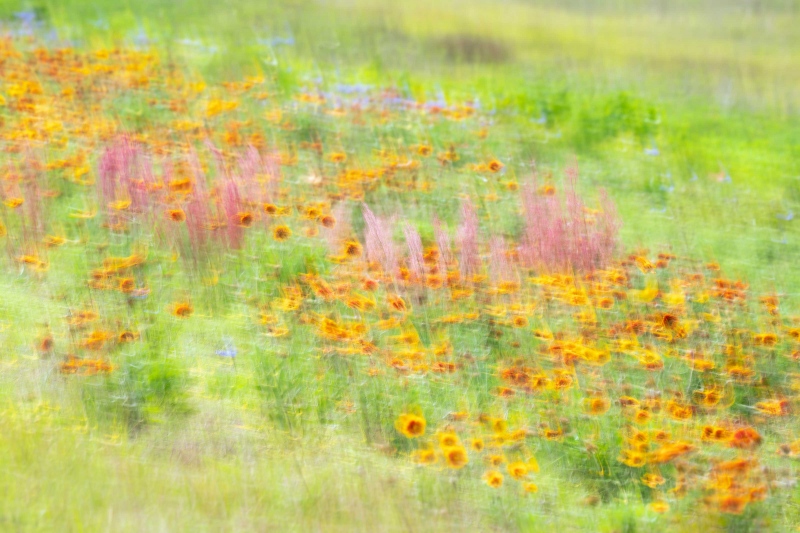
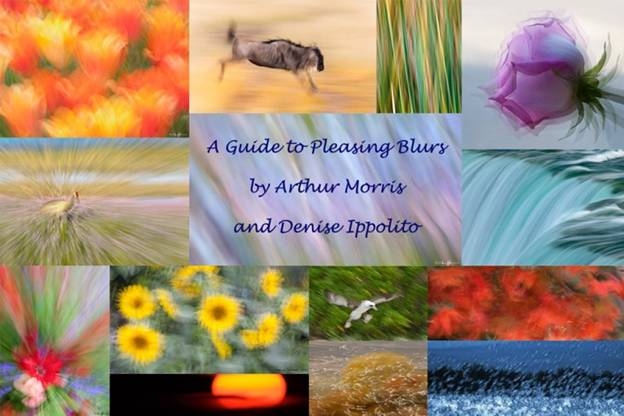
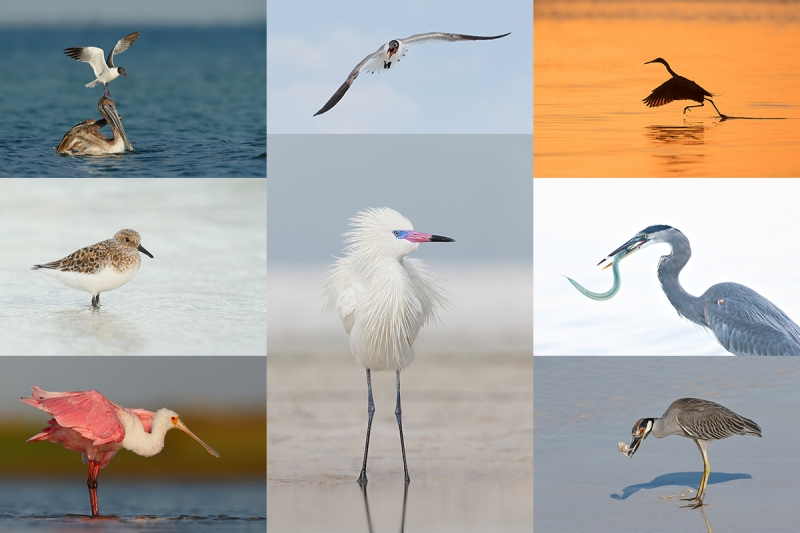
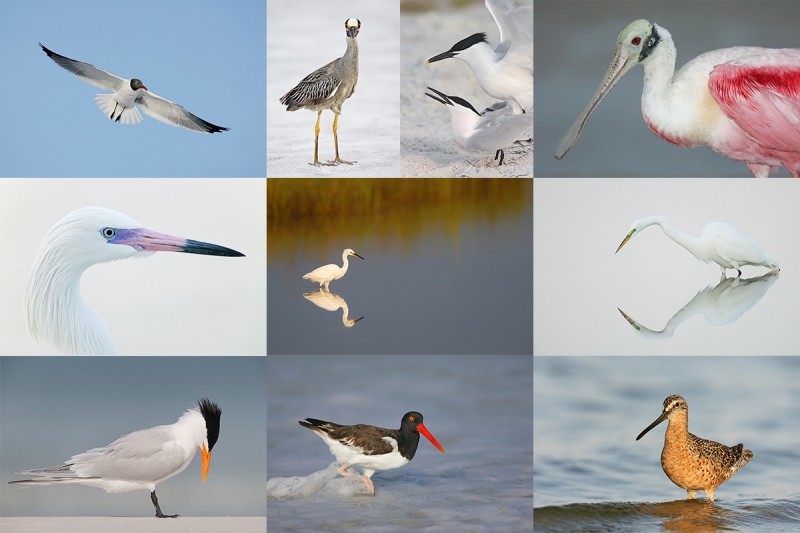
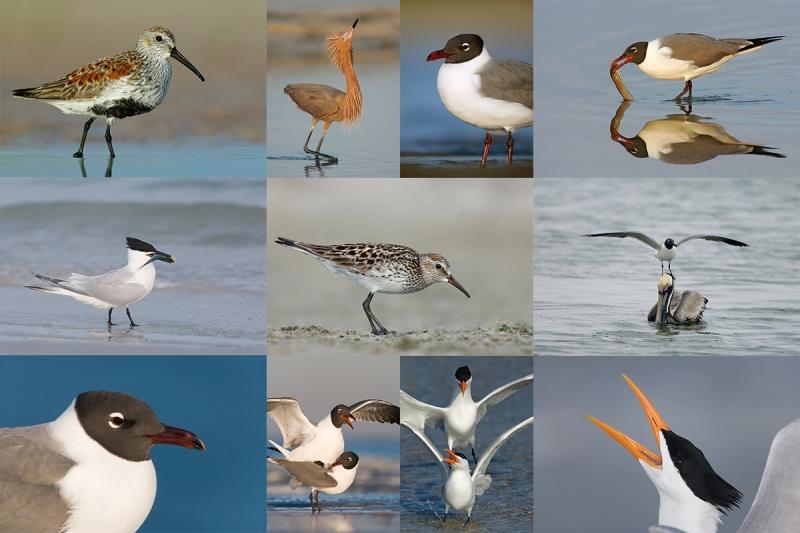
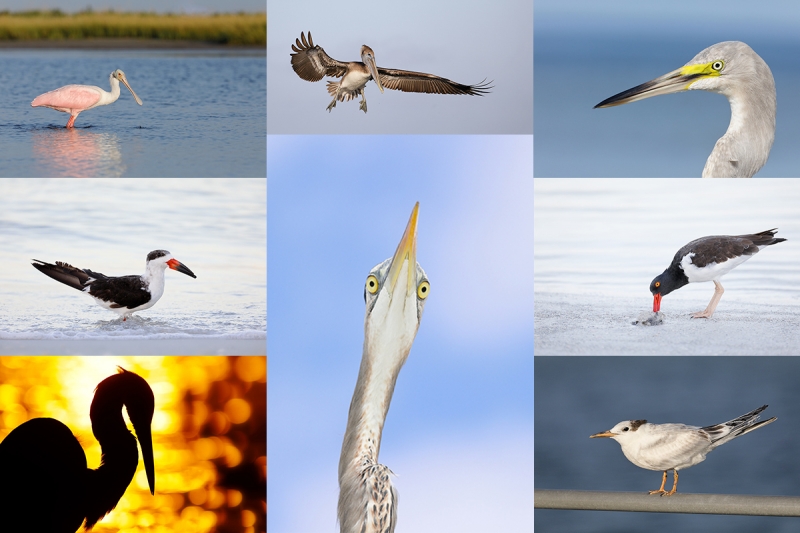













Hi, Artie. You know blurs are my thing. The color and amount of blur on this are fantastic. I’m on the fence about the composition. The “non-flowery” parts on the lower left and upper right on either side of flowers add symmetry and balance each other out but they also draw the eye.
That said, by no means would I classify this as garbage. You saw an opportunity to create an image and chose to shoot rather than keep driving. Most folks don’t stop and, consequently, miss some great opportunities. I shoot many images on the side of the road, out the window, many times while moving (with my wife driving). You don’t always have the ability to physically move into the best position to get the ideal composition. Sometimes you have to try to do the best with what you’ve got. I have no idea if that was your situation or not but, to me, this image is a success.
Sorry to write a novel. I guess my point is this: Please post more blurs!!!
Thanks, Joe. I did not know. For me, the image design is very strong. I love the diagonal line created by the brightest flowers. Different strokes …
with love, artie
Well I was there. This was a bit of a stop the car moment – color that was just too good to pass up and 15-20 mph wind that makes traditional photos of things impossible. Sometimes part of photography is just having fun and reinforcing the need to try different techniques and being more creative. Motion blurs, focus blurs, lens rotation, and other camera movements were all part of the TWO sessions we had yesterday with a roadside flower patch. I had over 600 photos – attempts at making something interesting and creative. I used focus blurs and wind blurs for the first session, and camera motion blurs for the second session.
I’d encourage everyone experiment a little more, have fun, and consider ways to create artistic images to complement photos of things.
Thanks, Eric. Over the past three days, Eric has been my Jekyll guide for the past three days, and has become my brother from another mother 🙂
with love, artie
I absolutely love it. The strong diagonal of the flowers cascades me through the image. Love the pops of blue and the vertical pinks. The one thing that I will mention is that I find the dark blob (a rock?) near the top to be a distraction, but cropping to remove it would ruin the composition. I would mend this in photoshop.
Thanks, Grace. Removing the blob would be great for a non-contest version. An option would be to move it to the right side of the frame where it might either be less distracting or a plus.
with love, artie
Beautiful, very painterly!
Gorgeous of course! Looks like a painting! Very nice work my friend!
Question: Why is f/16 @ 496mm wide open?
Thanks, Anthony. I agree. f/16 is stopped down one stop because I forgot to go out to the car and count clicks. From f/6.3 to f/16 is 2 2/3 stops. I will fix that now. So thanks again.
with love, artie
Hi, Artie. Are gorgeous and garbage the only options? I like the blur. It reminds me of an impressionist painting. Definitely not garbage for me. I like the clear daisies in the field of color. I’d like to see this is a big print.
I roast my chicken at 375, by the way.
Thanks David, I go lower because I never know how long it will be till I get back 🙂
with love, artie
In this blur, I like the colors making the diagonal lines with some pink verticals sticking up in the diagonal. There are only a few blurs I really like, most I don’t. On this one I’m in between. I wonder if I would like it more if it were even more blurry, showing more color than flower.
Mr Arthur
The image is not indicative of your best work. Just saying.
Mr. William,
Thanks for commenting. I am curious, is that a fact or is that you opinion? Just asking.
with love, artie
I like the wildflower image and it spurred me to finally purchase the Guide to Pleasing Blurs.
Well there’s a miracle!
with love and thanks, artie
Sorry but for me this is garbage but then I am never a fan of blurs.
Thanks for your honest opinion. with love, a
Hey Artie, I usually love your images but I don’t care for the roadside blur of the wildflowers. Had you not told me what it was, I wouldn’t have been able to guess. Just my two cents.
Thanks for your honest opinion. with love, a
Jordan, On second thought, it seems incomprehensible that you did not recognize the photo as a flower image.
with love, artie